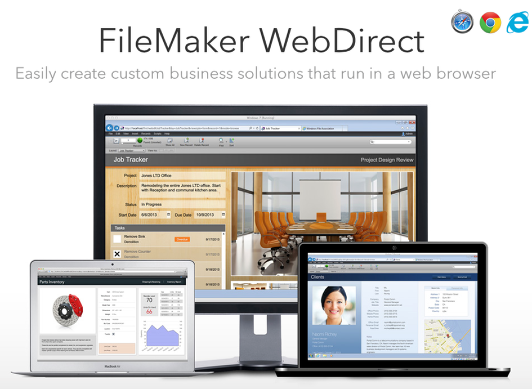Time marches on with software. Keeping up with the latest version of any software can be a delicate balance between hardware, operating system and the actual software. Upgrade too soon and your users can end up experiencing glitches, printer drivers haven’t been updated for the new operating system, old hardware won’t run the new operating system or the application itself. Upgrade too late and you may find your organization scrambling to deal with a software or hardware vendor dropping support for their product, or ceasing to release security updates for the operating system.
Timeline of Operating Systems and FileMaker Versions
FileMaker Pro 12, released in 2012 was a big change. It was the bugle call that things were changing in major ways. Earlier adopters jumped and loved it, but discovered occasional glitches.
Around the same time, Apple moved to Mountain Lion (July 2012), Mavericks (Oct 2013) and as I write this we are anticipating the release of Yosemite OS X (Fall 2014).
Windows moved from Windows 7 (2009) to Windows 8 (2012) and 8.1 (August 2013).
With both Mac and Windows platforms, older hardware is starting to drop off the support list. Security patches only go back so far. The latest web browsers and cool apps only run on newer versions of the operating system, requiring better hardware.
More cautious organizations didn’t need to move to it right away, but with the release of FileMaker Pro 13 in December 2013, now in the summer of 2014, in my opinion, the dust has settled, the bugs have been worked out and the time has come to seriously consider moving forward.
What’s New in FileMaker Pro 12/13

- CSS-based Custom Themes – makes it easy to deploy a custom theme throughout the solution AND change it as style requirements change.
- WebDirect – deploy FileMaker layouts in a browser. This makes FileMaker one of the easiest ways to create a low volume data-driven web site.
- Improved Document storage – the decision to allow document storage outside of the main data file makes it possible to build a robust document management system in FileMaker.
- Improved Security – encrypt databases at rest and during transmission to clients
- FileMaker Go – free iOS client allows for easy mobile access to data on iPads/iPods and iPhones
- Background Features – There are a whole host of new features that allow a developer to speed up reports and general actions in FileMaker Pro
- Developer Love – The new features are too numerous to mention, but highlights include the ability to hide objects conditionally, popovers, slide panels. These features give FileMaker developers new tools to improve the interface of your solution, making your users more efficient.
- New pricing comes into place in September 2014
File Format Change

FileMaker Pro 12 was a big change in file format for FileMaker Pro. The FileMaker 7 format (.fp7) ran on FileMaker Pro 7 through FileMaker Pro 11. FileMaker Pro 12 introduced the .fmp12 format, which presumably will run safely on a number of incremental upgrades. The current version is FileMaker Pro 13 and it happily runs the .fmp12 files.
Upgrading an older FIleMaker Pro file is a simple one-time operation that involves opening the .fp7 file with FileMaker 12/13. Once a file has been converted from .fp7 to .fmp12, it can no longer be opened in anything less than FileMaker Pro 12.
What happens after you convert the file?
When that simple conversion has been done, there are a whole host of improvements that can be added by the developer to improve the interface look, speed up reports and improve security. Using ExecuteSQL, or running Scripts on Server allow for some major speed gains and simplification of the database structure.
The improved document management capabilities open entire new categories of abilities for FileMaker Pro. Track waiver forms, signed contracts etc, by storing them as PDFs within FileMaker Pro. The server can be set up so that the documents are stored on a separate folder or drive, where they can be accessed by other applications if needed. Because the documents are no longer stored within the FileMaker Pro file, backups can be faster and the risk of data corruption minimized.
WebDirect and FileMaker Go allow the database to be deployed in a web browser or on an iPhone/iPad. For occasional users, allowing them access through a web browser can eliminate the need to install a copy of FileMaker Pro on their computer. Mobile users can benefit by getting access to the data while on the go.
Many of the new features of FileMaker are hidden in the background, where the developer can enjoy the benefits of a modern development environment. The developer can use elements like popovers, slide panels and conditionally hide objects to make a much cleaner and more familiar interface for users. Rollovers give users feedback on things like buttons, and give them an environment closer to what they are used to from web pages. FileMaker Developers love to use the latest tools. It can be painful to go back to old ways of doing things.
Security can be improved by turning on SSL for transmissions of data from the server to the client. FileMaker Server 13 has the ability to host a database in an encrypted state, so that if the server is hacked and the database stolen, it cannot be opened.
System Requirements for FileMaker Pro 13

To get all these wonderful new features, FileMaker has had to stiffen the requirements in both the hardware and operating system categories. You need modern hardware to run FileMaker Pro 13.
Accessing your data in a browser through WebDirect

You also require a modern browser with reasonably fast hardware to access WebDirect:
- Safari 6.1.x and Safari 7.x
- Internet Explorer 10.x or 11.x
- Chrome 27.x
What you get with an upgrade to FileMaker Pro 13
Every organization must make its own call about when to upgrade, but if you do decide to make the move now, here are some benefits you can expect from moving to FileMaker Pro 13:
- Improved interface
- Potential for dramatically improved reporting speed using the run script on server script step.
- Improved security
- Document management capabilities
- Access from mobile and web platforms
- Happier developers
- Peace of mind that you are staying up to date and moving forward at the right time.
These changes don’t come automatically to your solution, it takes work from your developer to implement these changes in your FileMaker Pro solution. Budget time and money to make these improvements a reality.
Update: 2014-12-03 Yet another reason to start thinking about moving forward. FileMaker Inc., has announced the end of life for FileMaker Pro 11 for the fall of 2015.
On December 2, 2014, FileMaker announced that as of September 25, 2015, FileMaker 11 products will no longer be available for direct sales and support including technical support, replacement media, downgrade media, and downgrade license keys. Self-help will be available via the FileMaker Knowledge Base and the FileMaker Forum. FileMaker 11 products: • FileMaker Pro 11• FileMaker Pro 11 Advanced
• FileMaker Server 11
• FileMaker Server 11 Advanced FileMaker Pro 11 and FileMaker Pro 11 Advanced are qualifying products for single license upgrades to FileMaker Pro 13 or FileMaker Pro 13 Advanced until September 25, 2015. Note: FileMaker Go 11 was discontinued on September 30, 2013


 August 11, 2014
August 11, 2014 



Nice work.
Nitpick – you mention “Mavericks coming in 2014 – I think you mean Yosemite.
Thanks for the nitpicking. I was a little sleepy when I posted this. Fixed. I think I got the sequence right now.